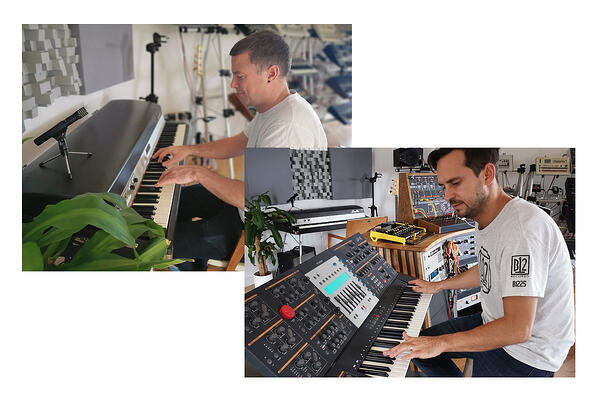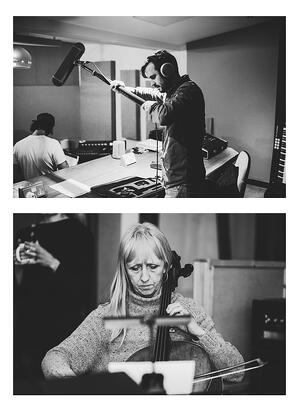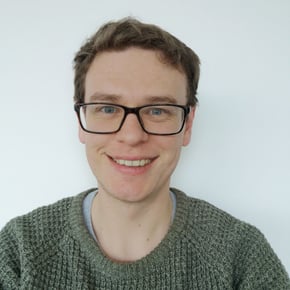Echoic Audio has been producing music and sound design for film, TV and advertising for over 10 years, accruing a long list of high-profile clients in the process. With their guest lecture at dBs imminent, we sat down with founding members David Johnston and Tom Gilbert to hear how it all began and their tips to those trying to find their way into the audio industry.
Could you tell us a little bit about Echoic Audio first got started?
Echoic was started by myself and long term musical friend Tom Gilbert. We met in Bristol in the early 2000s through a shared love of electronic music. We DJ’d together and ran a nightclub called Kingpin. Back then I was an audio producer at Kiss Radio and Tom worked at the BBC. We always knew we wanted to work in sound but it was tricky getting a foot in. We found a studio space and put all our kit together and created Echoic.
Before starting Echoic, had you or Tom ever dabbled in making music for picture or sound design?
I had created music to picture in my MA at Bath University. I studied on the Creative Music Technology course. Tom had created some sound design pieces for a couple of animations and ads whilst freelancing as a video editor at Hurricane Media. These pieces became the start of our portfolio.
It’s incredible to see the work you’ve produced over the years, for some pretty massive names too. How did you build that portfolio of clients?
When we started out we were just very determined and rang as many production companies as we could think of and offered our services. Having a vision of our studio in 5 years time was important too. You don’t go from zero to a big Nike advert over night. But we took each project one step at a time and always aimed to do a good job and meet more people. It was a long process, but we knew we wanted to succeed.
We’ve noticed that you’re often working at various studios around the country. Do you find the change in scenery has a positive impact on the project you’re working on?
Well most of our work is done from our studio on Whiteladies Road. When we record larger orchestral arrangements we have used Invada Studios also based in Bristol. Plus last year we were lucky enough to go to Devon Analog Studio for a fun jam session. It’s inspiring to have a such a big change of scenery.
 (David and Tom at Devon Analog Studio)
(David and Tom at Devon Analog Studio)
You and Tom both have experience in motion graphics and video editing. How big an impact has this had on the success of Echoic Audio and would you recommend budding sound designers to get a similar experience too?
Tom has video editing experience. I dabble in pretty basic graphic design stuff. I think there is a huge cross over among all these disciplines. Any creative process can help another one as a lot of the time it's about problem solving or story telling. It’s not essential, but I would certainly recommend similar experience. It can help thinking about things in different ways. Photography too is another good example.
You’ve both mentioned how the sound design community is much more closed off than other areas and there’s not much in the way of resources for new practitioners. What would be your top tips to help someone get started?
Our top tip would be just practice as much as possible on clips that inspire. Practise really is the key. There’s no rule or best practises, so just experiment and listen. If you can really listen and dissect other work you’ll be able to recreate various aspects in your own style.
The current age of film and television seems to be leaning heavily on sound design for its scores, opting for atmosphere and ambience over melody. Do you think the field will open a little more as a result or still remain a ‘dark art’?
It’s really hard to say. I hope so, though. It’s relatively easy to acquire to tools to begin experimenting and building the necessary skills for sound design or composition for picture, however that has meant it’s harder to find work.

What do you typically look for in a potential new candidate, whether they’re a composer or sound designer?
As we work largely in advertising we are thrown all sorts of different briefs. So we look for someone who is flexible, dynamic and has a good knowledge of a wide range of styles. But also someone who can have a laugh and a joke is a bonus. Someone we feel we can get along with day to day. We’re a small team so rapport is also important.
What are your must-have tools for creating, both software and hardware?
We mainly use Logic for sound design and a mix of Logic and Ableton for writing. Some decent plugins, a microphone, some sample packs and great ideas are the only tools you really need.
A lot of the time people list an expensive plugin or piece of hardware that’s invaluable to their creative process, but not particularly accessible. Do you have a favourite piece of software or hardware that doesn’t have a huge price tag?
Currently loving the Behnringer DeepMind 12. It's an affordable polysynth based on the Juno 106. Certainly not invaluable to our process, but is a lot of fun. Plus we have some older FX racks like the Eventide H3000SE and Ensoniq DP/4. Both of these have a wonderfully warm and slightly saturated sound. The delays and reverbs are completely different to something you can create in a plugin.
What’s been your proudest moment at Echoic Audio so far?
Probably our proudest moment so far has been watching the OFFF Festival Main Titles in Barcelona early this year with our score in front of about 2000 people.
What one piece of advice would you give to anyone looking to find success in the audio industry?
Work on projects that you love. Try not to be too disheartened by closed doors. Just keep at it. Also meet people both online and in the real world.
FIND OUT MORE:
Echoic Audio
Instagram
Facebook
Twitter
Vimeo
Do you long to pursue a career in sound for film or TV? Take a look at our Sound for Film & TV degree courses.


.jpg?width=300&name=Echoic%20Audio%20(Featured%20Image).jpg)